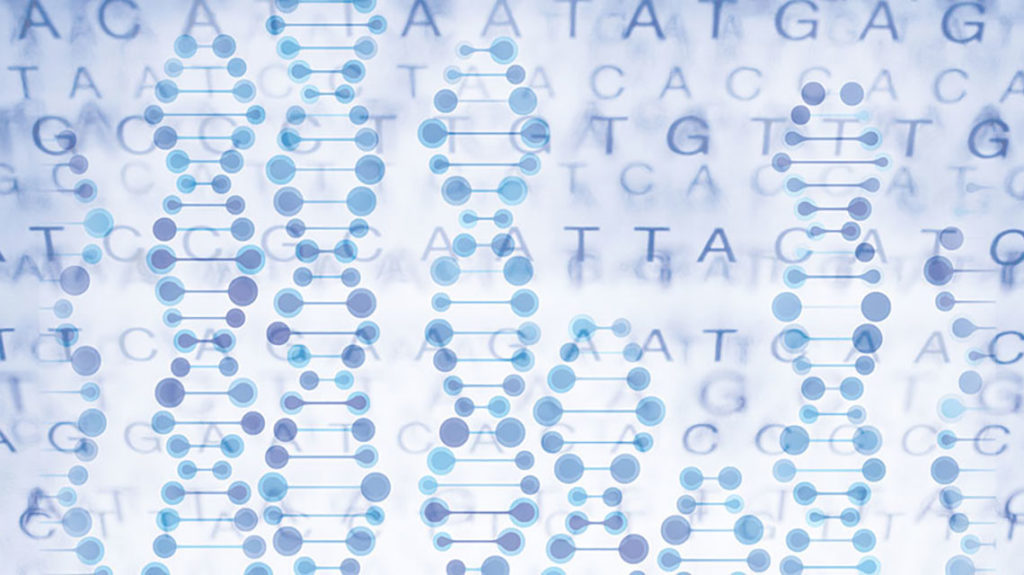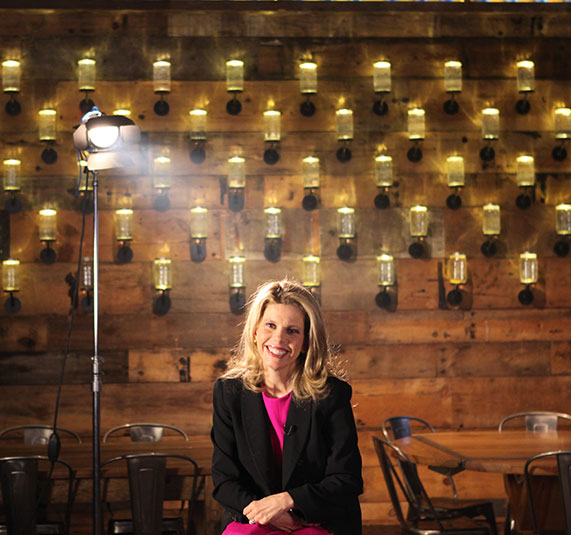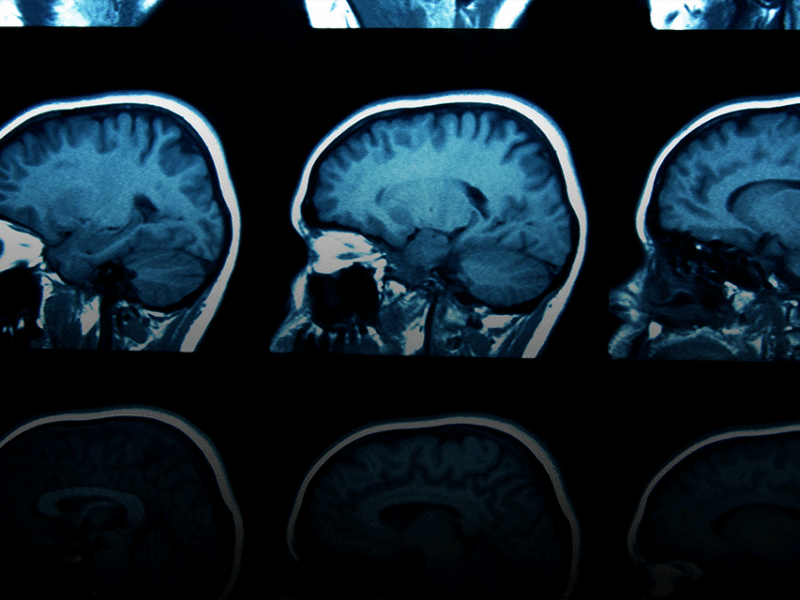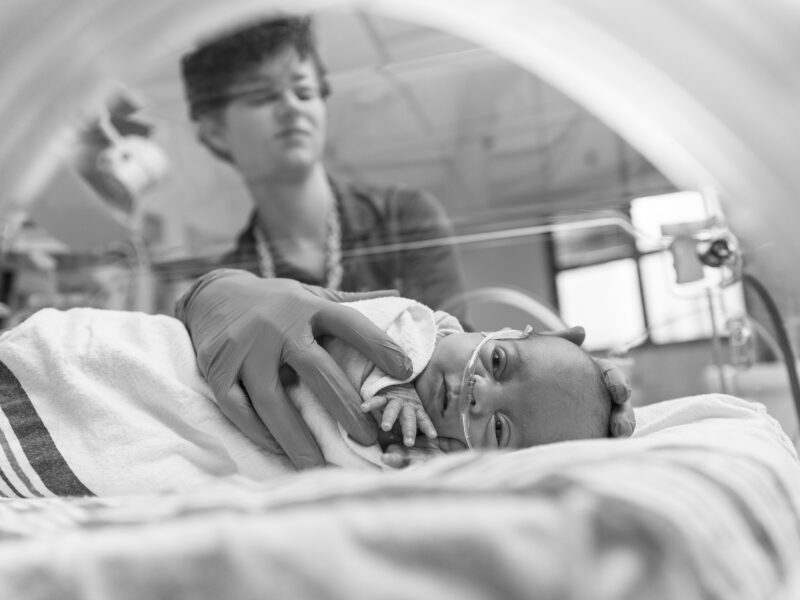Achieving CLARITY
Achieving CLARITY https://pediatricsnationwide.org/wp-content/uploads/2020/11/Achieving-Clarity-Header-1024x575.jpg 1024 575 Abbie Miller Abbie Miller https://pediatricsnationwide.org/wp-content/uploads/2023/05/051023BT016-Abbie-Crop.jpg- April 29, 2016
- Abbie Miller

Multidisciplinary team from Nationwide Children’s wins international genomics competition.
Accurate, patient-centered, comprehensive. That’s how the judges and leaders of the CLARITY Undiagnosed Challenge described the work of a team from Nationwide Children’s Hospital. Those same words could be used to describe the highly motivated and diverse team who surprised themselves by winning the challenge.
“When we entered the challenge, we knew we would learn a lot. We believed we could help the families involved in the cases in their search for answers. But we didn’t know we would win,” says Peter White, PhD, team leader and director of the Biomedical Genomics Core in The Research Institute at Nationwide Children’s.
In 2015, Dr. White and his team of clinical practitioners and research scientists entered the CLARITY Undiagnosed Challenge with 25 other teams from around the world.
The CLARITY challenges are led by Boston Children’s Hospital as a way to bring together the best teams in the world to address genomic research and clinical challenges. The first challenge, launched in 2012, focused on interpreting genomics data.
In 2015, the program coordinators met Katia Moritz, a psychologist and documentary filmmaker. She is also a patient with an undiagnosed illness. This meeting inspired the course of the next challenge and brought the undiagnosed illnesses of five families into focus for a worldwide crowdsourcing effort.
Katia’s Story
Katia Moritz, PhD, ABPP, is clinical director of the NeuroBehavioral Institute and a board certified cognitive and behavioral therapist specializing in children and families affected by anxiety disorders, autism and obsessive compulsive disorders. Upon waking from a routine endoscopy in 2010, she began suffering from flu-like symptoms, severe pain in her upper right quadrant, difficulty swallowing, headaches, low grade fevers, pain behind her eyes, muscle fatigue and cramping, hair loss, blood-flow difficulties in her extremities and other struggles. Her muscle problems are getting worse and, at times, she has trouble breathing.
Extensive testing and visits to countless specialists failed to diagnose the cause of Dr. Moritz’s symptoms, and she joined the ranks of the millions of people around the world suffering from an undiagnosed disease.
In her journey to find an answer for her own illness, Dr. Moritz began meeting other undiagnosed patients. Even though their symptoms were different, they were connected by the loss, abandonment and frustration they felt with a medical system that does not have a way to care for them.
“Undiagnosed patients are looking for a community, a sense of identity and a medical home where they can receive treatment,” she explains. “We truly are medical refugees looking for asylum.”
It was this, and her strong desire to help others, that led to the documentary film UNDIAGNOSED: Medical Refugees. For the past several years, Dr. Moritz and her production team have been traveling around the country documenting the stories of undiagnosed patients.

Katia Mortiz on the set for her documentary about searching for a diagnosis.
“My life is about helping people with severe and debilitating anxiety disorders,” says Dr. Moritz. “Because I am healthier than many of the undiagnosed patients, I am also able to help the undiagnosed community by being an advocate to the patients and their families who are fighting to get proper care and support in order to survive.”
In interviewing the leaders at the Undiagnosed Diseases Network (UDN), a project of the National Institutes of Health (NIH), Dr. Moritz was introduced to CLARITY co-organizers, Isaac Kohane, MD, PhD, chairman of the Department of Biomedical Informatics at Harvard Medical School, and Alan Beggs, PhD, director of The Manton Center for Orphan Disease Research at Boston Children’s. Out of their meeting, CLARITY Undiagnosed was born.
CLARITY Undiagnosed
CLARITY Undiagnosed became a call to arms for the five patient families featured in the documentary. Applying next-generation sequencing and genomic analysis, teams from around the world worked to answer one question: Why are these patients sick?
“We wanted to put the power of genomics into action,” says Dr. Beggs. “The patients in the challenge were the toughest of the tough. They all had extensive previous workups and a slew of the country’s best physicians reviewing their cases.”
The crowdsourcing approach of the international challenge brings together the brightest minds in clinical and research genomics. With the world’s experts focused on the same small set of patients, organizers hoped for a breakthrough.
According to Dr. White, who led the winning Nationwide Children’s team, undiagnosed patients face three possibilities with each genomic study:
Door #1: They receive a specific diagnosis for which there is a known treatment.
Door #2: They receive a specific diagnosis for which there is currently no known treatment, and their clinical care remains focused on symptom management while they wait for more research. This outcome is still extremely helpful because it ends the odyssey to find the cause and also, often provides the family with accurate information about the risk of the disorder happening again in the family.
Door #3: Nothing turns up. This is, of course, disappointing for the families and the medical professionals. However, the disorder could still be genetic because the current belief is that, at most, 50 percent of such disorders can be detected using this technology.
“One of the important things to keep in mind for these families is that knowing the cause of their illness — even if it doesn’t lead to a therapy — is life changing,” says Dr. White. “We were driven by the desire to give these families answers.”
Getting to Work
The research teams participating in the CLARITY Challenge were given whole genome sequences for each of the patients in question and selected affected and unaffected family members. From there, it was up to each team to analyze and interpret the findings and ultimately, generate a report containing meaningful information to be shared with the families.
“The current state of the science is this: if you are undiagnosed and undergoing genomic studies, there is a 1 in 3 chance of finding a mutation we can attribute the disease to,” says Dr. Beggs. “But why 1 in 3? Can we do better?”
Next-generation sequencing produces incredible amounts of raw data to be analyzed before a clinical team can begin to apply the data to diagnosing the patient. Churchill, a novel computational pipeline developed by Dr. White and his lab, expedites this genomic analysis without compromising quality or accuracy.
“Churchill has been tested time and time again and found to be an unparalleled tool for providing fast, accurate analysis of genomics data,” says Dr. White. “By using this tool, we could move on to the next step quickly and with confidence.”
The next step, explains Dr. White, was to annotate each patient’s genetic variants — sites in their genome that differed from the gold standard human reference genome — in order to narrow the list to the 200 to 300 variants that may be functionally relevant to their disorder. Then, they were faced with the daunting task of analyzing those few hundred variants to determine if any of them could be implicated in a disease.
This prioritization process was a complex, cooperative effort between the research and clinical teams.
“The bioinformatics component, the sequencing and even the analysis — with the help of Churchill — is constantly getting better, faster and cheaper,” says Gail Herman, MD, PhD, principal investigator for the Center for Molecular and Human Genetics at The Research Institute at Nationwide Children’s and clinical leader on the CLARITY team. “However, taking the analysis data and figuring out which variants might be implicated in disease processes is a challenging endeavor requiring extensive collaboration between research and clinical teams.”
“These are the most clinically complex cases, overall, I’ve ever seen,” Dr. Herman continues.
“With the informatics and computation getting better, a big differentiator in genomics analysis is clinical skills. We have top-level clinicians here, and we threw everything we had at these cases.”
The Importance of Reporting
In the CLARITY Undiagnosed challenge, reporting was a key component of the competition.
“The first CLARITY challenge was about data, science and gaining knowledge,” explains Dr. Beggs. “But CLARITY Undiagnosed was all of that and how to bring it back to the patient and their medical team.”
When presenting genomics results to patients and their families, the way the information is presented is very important, says Dr. Beggs. In particular, physicians and researchers need to talk about the boundaries of what they know: sensitivity and specificity.
“Dr. White’s team did this well. The technical and clinical reports and the genetic counseling letter for families were outstanding examples of how we need to share the results of genomics studies with physicians and families in a meaningful and accessible way,” says Dr. Beggs.
Using guidelines developed by the American College of Medical Genetics and Genomics (ACMG) for classifying sequence variants and for reporting secondary findings, all of the data were gathered into the reports and the letters.
According to Dr. Herman, Nationwide Children’s long history of providing state of the art clinical genetics patient care and their multidisciplinary approach to the challenge provided the necessary groundwork to stand out in terms of reporting.
“Multidisciplinary is a term that’s probably overused, but that’s what our team was,” adds Dr. Herman, who is also a professor in the Department of Pediatrics at The Ohio State University and past president of the American College of Medical Genetics. “To do this work, multidisciplinary is what you need.”
“The main objective of CLARITY Undiagnosed was to merge the research and clinical sides of the problem. Nationwide Children’s picked up on this concept and really embodied it — particularly with their inclusion of the patient letter,” says Dr. Moritz, who was also part of the challenge planning committee. “It’s science, but it’s about the patient.”
To bridge the gap between physicians and family and to mimic the type of care they would provide to a family seen at Nationwide Children’s, the three genetic counselors and physicians on the CLARITY team included genetic counseling letters to the families. These letters compassionately explained the work the team had done and what was found in language a lay person could understand.
“Having a letter following up the genetic counseling conversation is very important, and a lot of research has been done to show its importance,” says Dr. Beggs.
In this case, the letters were supplied in lieu of face-to-face counseling.
“Because we were not able to meet with the families in person, it was crucial for us to provide the letters,” says Elizabeth Varga, MS, LGC, a licensed genetic counselor who is also an adjunct assistant professor of Pediatrics at Ohio State.“The letters were very similar to patient letters we do for any patient who has had genetic testing.”
In any genetic study, but especially in genomic studies, secondary — originally called incidental — findings are common. When researchers perform genomic testing, they get data not only about potential disease-causing genes related to the patient’s current disorder or illness, but also about genes that might carry unrelated long term risks for their own or their relatives’ health. Examples include genes associated with a strong predisposition to cancer or potential sudden cardiac death.
Though searching for those genes was not the objective, researchers have a clinical and ethical obligation to communicate the secondary results to the family.
The President’s Commission on Bioethics and ACMG recently recommended, if patients so choose, a search for those genes whenever clinical genomic sequencing is performed.
“In genetic counseling, you have to think about the ethical, social, familial and reproductive risks for the conditions and risk factors in the report,” Varga says.
“You have to consider the problem of secondary findings,” agrees Dr. Herman. “When we get to clinical applications of genomics, it will be important to consider: What do you look for? What do you report? The more you include in the report, the more clinical and counseling time will be required. This is not just a matter of ethics but of cost and practicality. You have to balance the power of genomics with other considerations.”
Next Steps
“At the end of the challenge, no previously described human diseases were identified,” says Dr. Beggs. “In several cases, the results provided a likely basis for the patient’s disease, but more research is needed to confirm causation.”
In one family, Dr. White’s team found a de novo mutation, which he suggests has a strong likelihood of being implicated in the disease process.
The gene GSK3A, while not linked to any known human disease, is implicated in a pathway that regulates a gene known to cause a certain disease. This particular patient suffers from symptoms consistent with the disease.
“We don’t know this is the cause, but we were able to pose an actionable hypothesis,” says Dr. White.
This seemed to be the overall trend.
It’s important to remember that while genomics is a powerful tool for diagnosing rare diseases, it usually doesn’t stand on its own. Once a candidate for pathogenesis is identified, functional testing to prove causation is needed to confirm the finding in most cases. This is typically accomplished through in vitro studies or animal models.
“When you find a genetic variation in so many patients with the same phenotype, you suspect association,” explains Dr. Beggs, “So you can make a hypothesis, but to really know causation, you need to do more work.”
This additional effort is critical for expanding the knowledge base that could ultimately lead to answers for families. But it takes time. It takes resources. And it takes persistence.
In competing with leading institutions from around the world to provide meaningful genomic results to five families living with undiagnosed illnesses, Dr. White’s team created a model for genomic study. Not only did they reinforce the importance of making information accessible to physicians and families, but they also brought new hope to the families whose cases were presented.
“The key to our success was our team,” says Dr. White. “Having clinical and research professionals on the team enabled us to present concise, meaningful data in an approachable and useful way.”
Dr. White and his team plan to build on their success and continue to apply all they have learned. Using the CLARITY Undiagnosed prize money and a grant through The Nationwide Pediatric Innovation Fund, a new research genomics program at Nationwide Children’s has been launched.
“We showed we could do it,” says Dr. Herman. “Let’s keep going.”
Living Undiagnosed
To spend a few minutes talking with Dr. Moritz is to get a window into the life of someone with an undiagnosed illness. During our conversation, Dr. Moritz shared some important insights into what the medical community can do to help patients with undiagnosed diseases.
“One of the important things for doctors to ask patients with undiagnosed diseases is ‘How do you function?’” Dr. Moritz says. “When conventional medical testing fails to pinpoint the cause of a patient’s symptoms, many doctors will throw up their hands and suggest the patient is suffering from a psychiatric condition. But one major difference between a psychiatric illness and a physical one is how you function.”
“Undiagnosed patients are trying to live to the best of their abilities,” she explains. “They are often accomplishing amazing things despite their limitations and uncertainty about the future. However, patients with severe anxiety and other psychiatric conditions cannot function. They become more paralyzed by their symptoms than an undiagnosed person does.”
Besides the unresolved symptoms, unanswered questions and uncertain future, patients with undiagnosed illnesses also must chart their course through a medical system that is not designed to treat people without diagnoses.
“The medical system cannot treat undiagnosed patients the same way it treats patients with a diagnosis,” says Dr. Moritz. “First, there’s the need for research and clinical collaboration. Second, you can’t diagnose someone with an unknown, unsolved, undiagnosed illness in a 20 minute visit. Doctors need to have a way to be paid for the research, the thinking, the solving and collaborating.”
Dr. Moritz also says doctors need to feel comfortable not knowing: “A scientist who doesn’t know is one who discovers.”
Undiagnosed Film: Watch the trailer
Reference:
Corsmeier DJ, Herman GE, McBride KL, Flanigan KM, Pyatt RE, Varga E, Hashimoto S, Fitzgerald-Butt SM, Kelly BJ, Fitch J, Kuck H, Moosavinasab S, Huang Y, Lin S, White P. CLARITY Undiagnosed Challenge Final Report. The Research Institute, Nationwide Children’s Hospital. 2015.
Photo Credit: Nationwide Children’s; Undiagnosed Documentary (Katia Moritz portrait)
About the author
Abbie (Roth) Miller, MWC, is a passionate communicator of science. As the manager, medical and science content, at Nationwide Children’s Hospital, she shares stories about innovative research and discovery with audiences ranging from parents to preeminent researchers and leaders. Before coming to Nationwide Children’s, Abbie used her communication skills to engage audiences with a wide variety of science topics. She is a Medical Writer Certified®, credentialed by the American Medical Writers Association.
-
Abbie Millerhttps://pediatricsnationwide.org/author/abbie-miller/
-
Abbie Millerhttps://pediatricsnationwide.org/author/abbie-miller/
-
Abbie Millerhttps://pediatricsnationwide.org/author/abbie-miller/
-
Abbie Millerhttps://pediatricsnationwide.org/author/abbie-miller/







